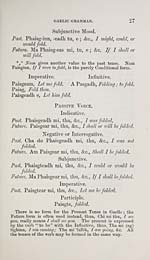Download files
Complete book:
Individual page:
Thumbnail gallery: Grid view | List view

26
GAELIC GRAMMAR,
as meaningless, useless, and perplexing. Any one can see
that eigin, eile, cuid, each, iad so, da b'e, each a cheile, da h'e
ail- bith, &c., &c., are some of them adjectives, some nouns,
some phrases, and some whole sentences, and there can be
no reason or excuse for retaining them as pronouns.
The Demonstrative Pronouns are also done away with.
The words usually so classified — .so, sin, sud. — are essentially
nouns. Their most common use is as Demonstrative Adjec-
tives : An duine so ; Am fear (s)ud ; Na fir sin.
When used -with the Preposition they often form adverbial
phrases : Tha e an so. Chaidh e git sin. It is simpler and
better always to parse these words as Nouns; but in the
analysis they must take the phrase value of Adverb or
Adjective as may be.
THE VERB.
The Gaelic Verb is, like the English Verb, de-
clined for Voice, Mood, Tense, Number, and Person.
The jSTumber and the Person is the same as
that of the Nominative.
There are three Principal Tenses — Present,
Past, and Future.
The Moods are — Indicative, Negative, Sub-
junctive, Imperative, and Infinitive.
Active Voice.
Paisg, fold.
Indicative or Affirmative Mood.
Past. Phaisg mi, thu, e ; sinn, sibh, iad, / . . . folded.
Future. Paisgidh mi, tlm, e; sinn, sibh, iad, /...
shall or ivill fold.
Negative or Interrogative Mood.
Past. Nach Do phaisg mi, thu, e, itc. Did not I
fold ?
Future. Nach Paisg mi, thu, e, &c.. Shall or will not
1 fold 7
GAELIC GRAMMAR,
as meaningless, useless, and perplexing. Any one can see
that eigin, eile, cuid, each, iad so, da b'e, each a cheile, da h'e
ail- bith, &c., &c., are some of them adjectives, some nouns,
some phrases, and some whole sentences, and there can be
no reason or excuse for retaining them as pronouns.
The Demonstrative Pronouns are also done away with.
The words usually so classified — .so, sin, sud. — are essentially
nouns. Their most common use is as Demonstrative Adjec-
tives : An duine so ; Am fear (s)ud ; Na fir sin.
When used -with the Preposition they often form adverbial
phrases : Tha e an so. Chaidh e git sin. It is simpler and
better always to parse these words as Nouns; but in the
analysis they must take the phrase value of Adverb or
Adjective as may be.
THE VERB.
The Gaelic Verb is, like the English Verb, de-
clined for Voice, Mood, Tense, Number, and Person.
The jSTumber and the Person is the same as
that of the Nominative.
There are three Principal Tenses — Present,
Past, and Future.
The Moods are — Indicative, Negative, Sub-
junctive, Imperative, and Infinitive.
Active Voice.
Paisg, fold.
Indicative or Affirmative Mood.
Past. Phaisg mi, thu, e ; sinn, sibh, iad, / . . . folded.
Future. Paisgidh mi, tlm, e; sinn, sibh, iad, /...
shall or ivill fold.
Negative or Interrogative Mood.
Past. Nach Do phaisg mi, thu, e, itc. Did not I
fold ?
Future. Nach Paisg mi, thu, e, &c.. Shall or will not
1 fold 7
Set display mode to: Large image | Transcription
Images and transcriptions on this page, including medium image downloads, may be used under the Creative Commons Attribution 4.0 International Licence unless otherwise stated. ![]()
| Early Gaelic Book Collections > Blair Collection > Gaelic texts for schools > (28) |
|---|
| Permanent URL | https://digital.nls.uk/79350719 |
|---|
| Description | A selection of books from a collection of more than 500 titles, mostly on religious and literary topics. Also includes some material dealing with other Celtic languages and societies. Collection created towards the end of the 19th century by Lady Evelyn Stewart Murray. |
|---|
| Description | Selected items from five 'Special and Named Printed Collections'. Includes books in Gaelic and other Celtic languages, works about the Gaels, their languages, literature, culture and history. |
|---|

